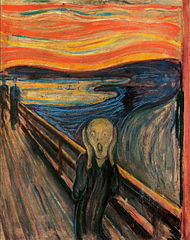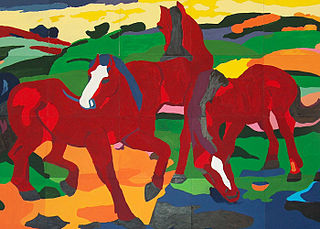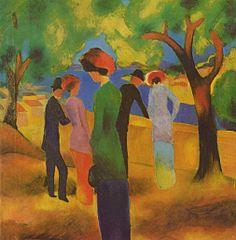General Overview
Surrealism began as a philosophical movement that said the way to find truth in the world was through the subconscious mind and dreams, rather than through logical thought. The movement included many artists, poets, and writers who expressed their theories in their work.
When was the Surrealism movement?
The movement began in the mid-1920s in France and was born out of an earlier movement called Dadaism from Switzerland. It reached its peak in the 1930s.
What are the characteristics of Surrealism?
Surrealism images explored the subconscious areas of the mind. The artwork often made little sense as it was usually trying to depict a dream or random thoughts.
Examples of Surrealism Art
The Song of Love (Giorgio de Chirico)
This painting is one of the earliest examples of Surrealist art. It was painted by de Chirico in 1914, before the movement really began. It combines a number of unrelated objects such as the green ball, giant rubber glove, and the head of a Greek statue. De Chirico was trying to explain his feelings for the ridiculousness of World War I through this painting. You can see this painting here.
The Persistence of Memory (Salvador Dali)
Perhaps the most famous of all the great Surrealist paintings, the Persistence of Memory is known for the melting watches as well as the clarity of the art. The painting gives you sense that you are dreaming and that time is irrelevant. You can see this painting here.
The Son of Man (Rene Magritte)
The Son of Man is a self-portrait of Rene Magritte. However, we can't see his face as it's covered by an apple. The painting shows a man in a bowler hat standing in front of a wall by the ocean. The sky is cloudy and, oddly enough, the man's face is obscured by the apple. If you look close enough, though, you can see the man's eyes. So perhaps he can see you. You can see this painting here.
Famous Surrealism Artists
Interesting Facts about Surrealism
Surrealism began as a philosophical movement that said the way to find truth in the world was through the subconscious mind and dreams, rather than through logical thought. The movement included many artists, poets, and writers who expressed their theories in their work.
When was the Surrealism movement?
The movement began in the mid-1920s in France and was born out of an earlier movement called Dadaism from Switzerland. It reached its peak in the 1930s.
What are the characteristics of Surrealism?
Surrealism images explored the subconscious areas of the mind. The artwork often made little sense as it was usually trying to depict a dream or random thoughts.
Examples of Surrealism Art
The Song of Love (Giorgio de Chirico)
This painting is one of the earliest examples of Surrealist art. It was painted by de Chirico in 1914, before the movement really began. It combines a number of unrelated objects such as the green ball, giant rubber glove, and the head of a Greek statue. De Chirico was trying to explain his feelings for the ridiculousness of World War I through this painting. You can see this painting here.
Perhaps the most famous of all the great Surrealist paintings, the Persistence of Memory is known for the melting watches as well as the clarity of the art. The painting gives you sense that you are dreaming and that time is irrelevant. You can see this painting here.
The Son of Man (Rene Magritte)
The Son of Man is a self-portrait of Rene Magritte. However, we can't see his face as it's covered by an apple. The painting shows a man in a bowler hat standing in front of a wall by the ocean. The sky is cloudy and, oddly enough, the man's face is obscured by the apple. If you look close enough, though, you can see the man's eyes. So perhaps he can see you. You can see this painting here.
Famous Surrealism Artists
- Giorgio de Chirico - In many ways this Italian artist was the first of the Surrealist painters. He founded the school of Metaphysical Art which influenced the Surrealist artists of the future.
- Salvador Dali - Considered by many to be the greatest of the Surrealist painters, Salvador Dali was a Spanish artist who embraced the idea and art of Surrealism.
- Max Ernst - A German painter who was part of the Dadaist movement and then joined the Surrealists.
- Alberto Giacometti - A French sculptor who was the leading sculptor of the Surrealist movement. He is most known fo forr his Walking Man sculpture which sold for over $104 million.
- Marcel Duchamp - A French artist who became involved in both the Dadaist and Surrealist movements. He was also associated with Cubism.
- Paul Klee - A Swiss painter who mixed Surrealism with Expressionism. His most famous paintings include Around the Fish, Red Balloon, and Twittering Machine.
- Rene Magritte - Magritte was a Belgian artist who liked to challenge people's ideas on what they should see through his Surrealist paintings. Some of his famous works include The Son of Man, The Treachery of Images, and The Human Condition.
- Joan Miro - Joan was a Spanish painter who was known for his Surrealist paintings as well as his own style and abstract artwork.
- Yves Tanguy - Yves was a French Surrealist known for his abstract landscapes that used a limited number of colors.
- The Surrealist movement was started by French Poet Andre Breton who wrote The Surrealist Manifesto in 1924.
- Some artists today consider themselves Surrealists.
- Surrealism means "above realism". Dadaism didn't mean anything. "Dada" was supposed to be a nonsense word.
- The founder of the movement, Andre Breton, originally thought that the visual arts, such as painting and film, wouldn't be useful to the Surrealist movement.
- Many artists, such as Salvador Dali, also made Surrealist films.
Work cited :-
1) https://www.ducksters.com/history/art/surrealism.php
2) https://youtu.be/wtPBOwE0Qn0












